STORY
LINES
DIGITAL CATALOGUE
STUDENT EXHIBITION
CURATORIAL
STATEMENT
Landscape is the vastness to dream our stories into.
As storytellers, we are humbled to create work in a place home to the oldest continuing cultures in the world with storytelling traditions intrinsically connected to the land. We invite you to share the feeling of vastness, connection to place and to consider storytelling and space from a different perspective.
Our exhibition is a response to the provocation of the Australian Exhibition of Countries and Regions, in collaboration with and inspired by lead creative Jacob Nash and his approach to Country and storytelling. Through our own stories of culture and place we have explored what it means to consider and translate place in storytelling. We want to share a sense of the vastness of the Australian landscape with our audience in Prague.
We are all from different places, but share common experiences in the vast Australian natural world. The rarity of our land, the sense of grounding and calm you get when surrounded by gum trees, diving under a crashing wave, or gazing up at the sky. The scale of this land comforts us. We feel wonder and gratitude for the tens of thousands of years this land has been cared for by First Nations people. We feel assurance that this land will endure us all. Our creative challenge is to capture the overwhelming and everchanging vastness of the land, within a confined space.
Our own stories of home and place, informed by our varied cultural backgrounds, inform the work and materiality of the space, and we invite our audience to take part of the work with them back to their places in the world, a reminder of our Australian reflections on place.
This work was dreamed and designed on the unceded lands of the Boon Wurrung people of the Eastern Kulin Nations, and the Jagera and Turrbal peoples, and we acknowledge and pay respect to their Elders past and present, custodians of these lands and waters that we now call home.
Always was, always will be, Aboriginal Land.
⋆
Always was, always will be, Aboriginal Land. ⋆
Always was, always will be, Aboriginal Land.
⋆
Always was, always will be, Aboriginal Land. ⋆
So how do we create this vastness in a confined space?
Australia is not a homogenous 'country' - the idea of a single nation is a colonialist construct that belies the diversity and richness of place and the multiple indigenous nations of this continent. While the appreciation of these knowledges has not always been at the forefront of Australian storytelling, we are privileged to share the unceded land of the oldest storytelling culture on earth.
The Australian Student exhibit at PQ23 celebrates First Nations perspectives and approaches to land, community, performance and design. Rather than taking a ‘national’ approach, students have been led by First Nations designer Jacob Nash through a creative process investigating their connection to place, the ideas of Country and belonging that inform Jacob’s scenographic approach, to connect with the unique environment of their corner of Australia.
Students began developing this work by being asked to share with each other one object that held stories of home. This storytelling process was the starting point for the work. Their personal stories, although very different, revealed the similarities and connections between their experience of home and family.
They found common ground in their shared experiences of the Australian landscape, and how its vastness can be overwhelming, comforting, grounding and liberating. The Australian sky feels more immense than in other places, and gazing up into this blue is something we all do from time to time, dreaming into the open air.
Image: Jodi Hope
The structural frame for the exhibition was the first parameter and mirrors the dimensions of Jacob’s design for the ECR. Suspended from the ceiling net, strands of naturally dyed rope and calico are knotted and woven to form a metaphorical landscape that the audience penetrate to reach a central clearing. This aperture invites the audience to look up into the sky.
The immersive environment is dyed using only plant material native to Australia, predominantly from eucalyptus trees. Eucalyptus creates a substantive dye from its leaves and bark.
Eucalypts are iconic Australian trees. The term ‘eucalypt’ includes approximately 800 species in the three genera Angophora, Corymbia and Eucalyptus. Almost all eucalypt species are native to Australia. Eucalyptus is by far the most common forest type in Australia covering 101 million hectares, which is 77% of Australia's total native forest area.









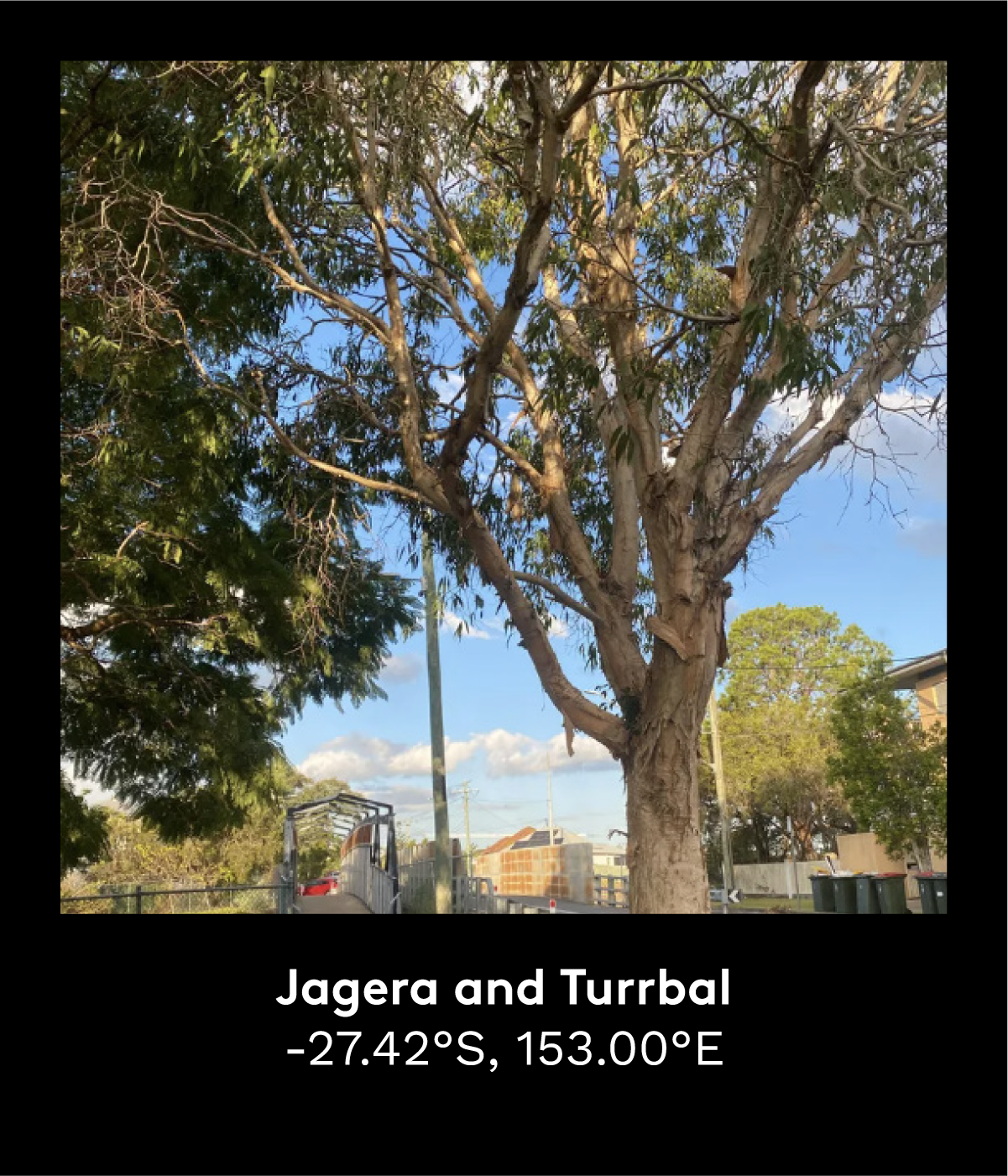

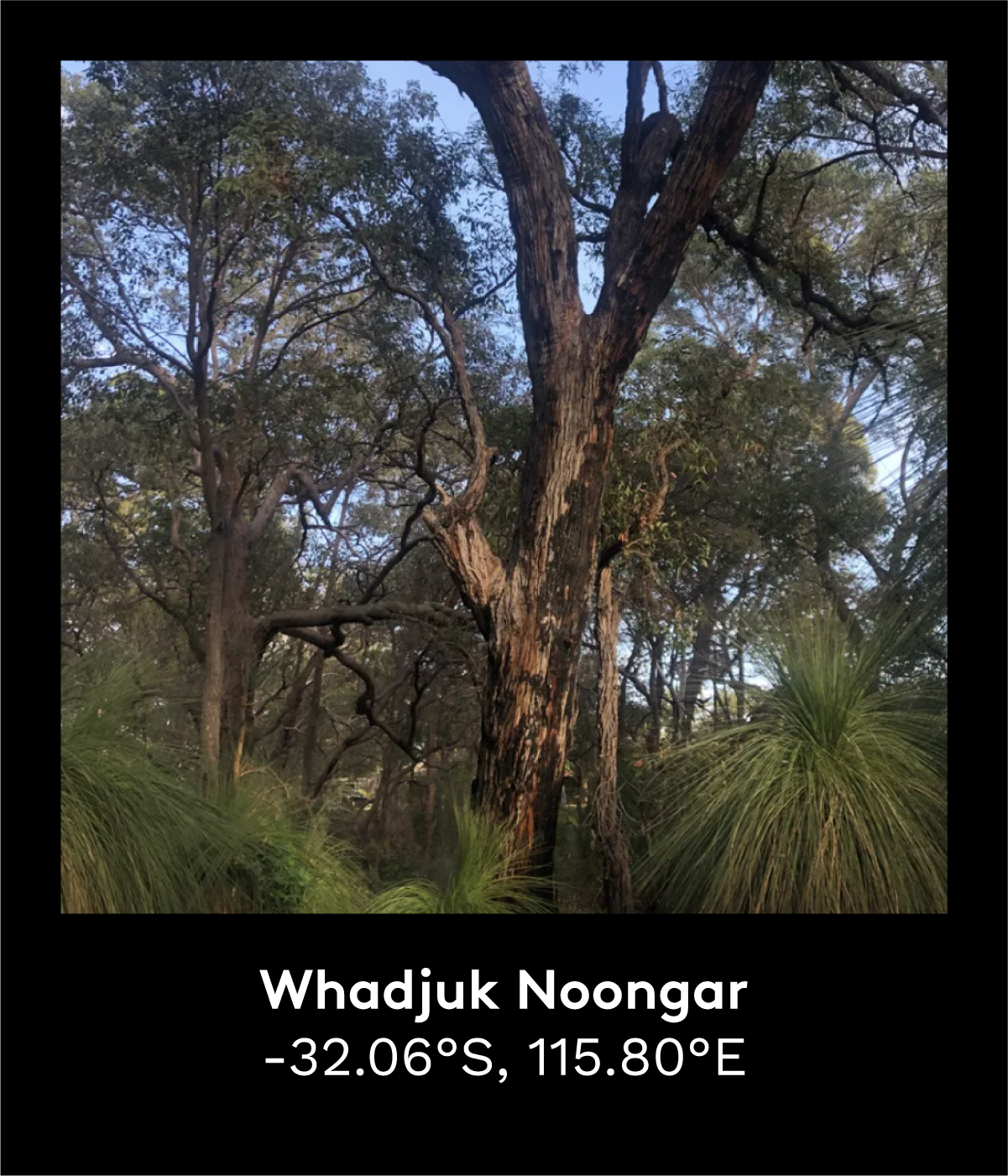





EUCALYPTUS SOURCES
This map shows the location of each of the trees we gathered our eucalyptus from, and the First Nations country the tree stands upon.
Click here to visit a google map with more details on the places and trees.
Interestingly, there are almost as many species of eucalyptus as there are First Nations groups as identified by Australian Institute of Aboriginal and Torres Strait Islander Studies (AIATSIS).
The words you hear in the soundscape are the words for ‘tree’ and ‘sky’ from Yankunytjatjara, Woiwurrung, Pitjantjatjara, Taungurung and Wadjak Noongar languages, just some of the Country the eucalyptus was gathered upon. These are only five of 840 First Nations languages recognised through AIATSIS. These languages are being recorded and documented through the 50 words project, which includes a map showing the geographic location of each of the language groups.
For another visual representation of the distinct groups that make up Aboriginal and Torres Strait Islander Australia, this map represents the general locations of these groups – a reminder of the richness and diversity of the First Peoples of this continent.
DYEING
PROCESS
Eucalyptus leaves, bark and flowers are gathered from fallen materials, and simmered in water to create the dye liquor. Multiple colours can be achieved through the use of different species and the addition of mordants including soy, iron, copper and alum.
Students explored multiple techniques to create textures and patterns in the dyeing, telling their own stories of place and home through these techniques. From pressing native flowers into the fabric, to twisting and knotting materials, to burning and scarring, this fabric has been immersed in the by-product of Australia’s native plants. We have grappled with expressing the vastness of country, from the every-changing ocean shores, the intertwined growth of mountain forests, to the charred remains of bushland after cultural burns.
Process Images by Jodi Hope, Louisa Fitzgerald, Lani Dwyer, Tessa Rixon, Josie James and Jo Briscoe

Batch one - Jodi Hope

Jake and the Skeleton - Louisa Fitzgerald

Jodi in the Sky - Louisa Fitzgerald

Circle of Friends - Louisa Fitzgerald

Dye batches in the pale winter sun - Jo Briscoe

First batch from West Brunswick on Wurundjeri Country - Jo Briscoe
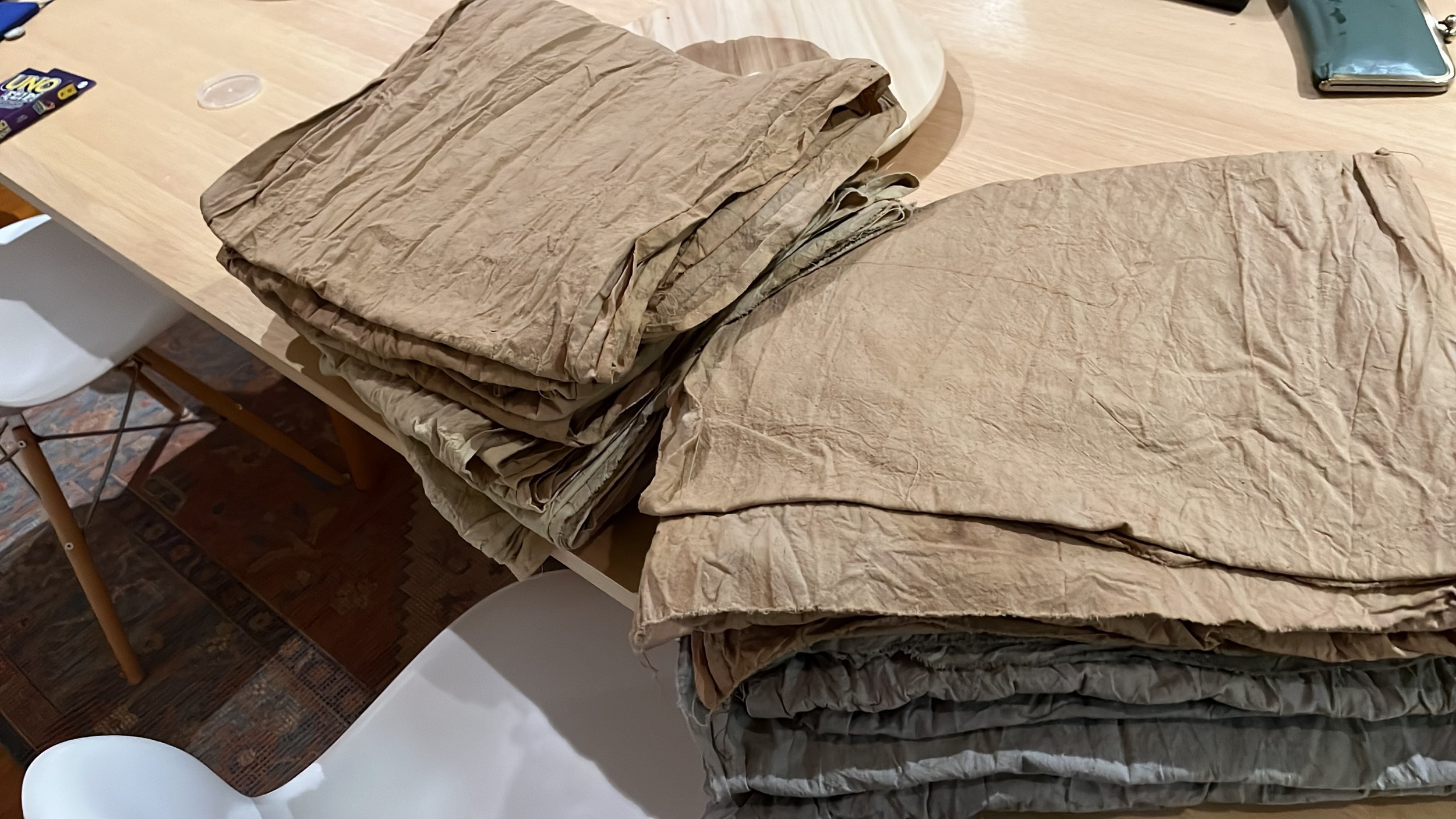
Dye batches dried: colour from Whadjuk Noongar eucalypts - Jo Briscoe

Experimenting during the creative development - Jo Briscoe

Troubleshooting - Jo Briscoe

Density Testing - Jo Briscoe

Bulleke-bek material from Wurundjeri Woi-wurrung - Jo Briscoe

QUT students were guided through the process by dying expert Rosa Hirikata - Tessa Rixon

Prepped and ready to boil - Jo Briscoe

The bark of the trees and the dye colours are the same palette! - Jo Briscoe

Creating the dye liquor - Jo Briscoe
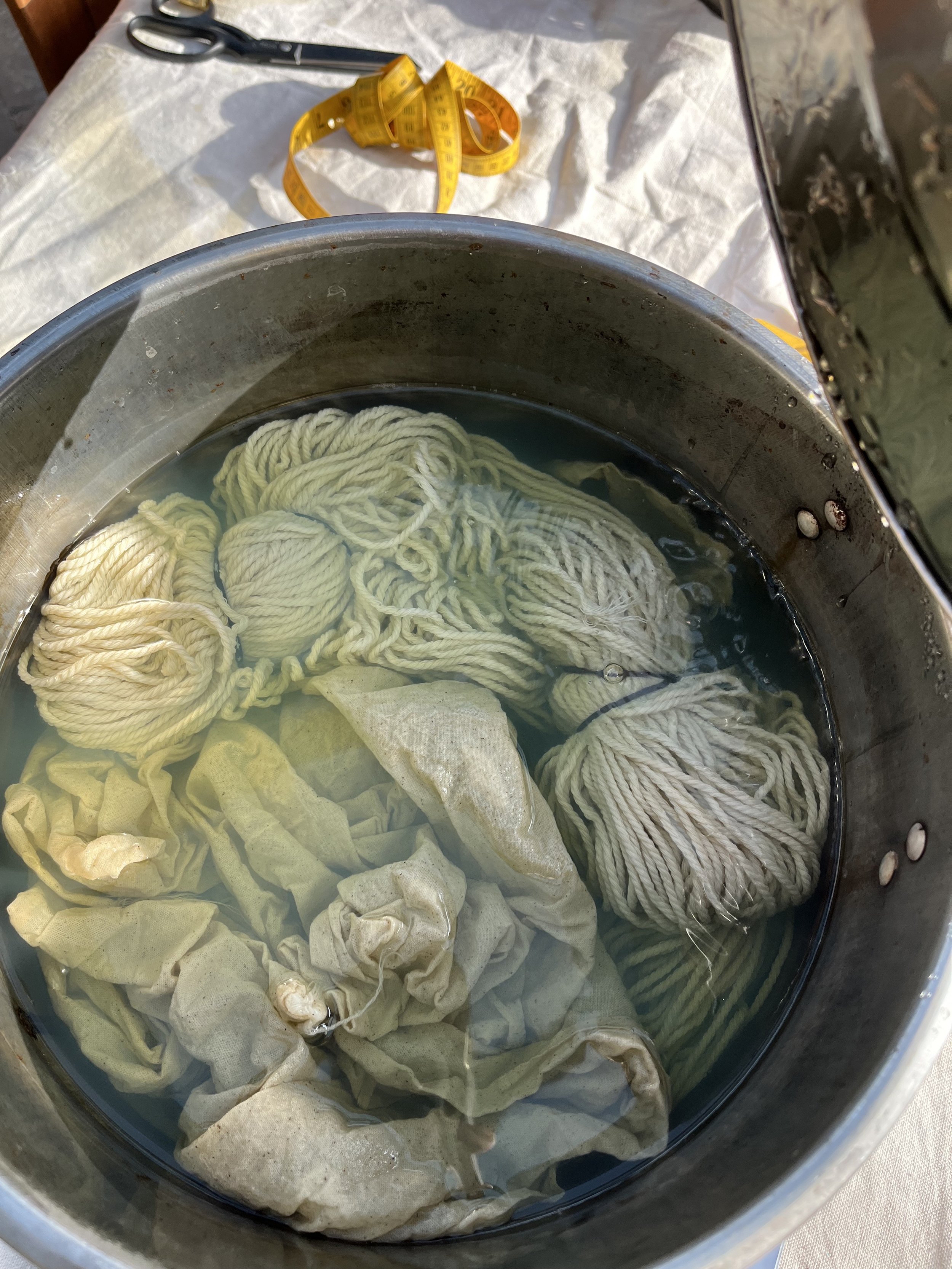
Mordanting with Copper Sulphate - Jo Briscoe

Drying in the pale winter sun - Jo Briscoe

The eucalyptus bark palette appears again - Jo Briscoe

Still drying batches of rope - Jo Briscoe

Ingredients - Jodi Hope

Tonal gradient - Jodi Hope

String theory - Jodi Hope

Height tests - Jodi Hope

Chalking - Jodi Hope

The Clearing - Jodi Hope
![This looks like bark [mordant testing] - Jodi Hope](https://images.squarespace-cdn.com/content/v1/64623453d28f3c73af1a665f/43fba77c-cc09-4378-9525-70a1e3ab4118/IMG_6697._JodiHopeJPG.JPG)
This looks like bark [mordant testing] - Jodi Hope

Eucalyptus leaves are folded into prepared fabrics, ready to be boiled - Tessa Rixon

Natural fabrics are gently boiled in eucalyptus water. Heat and contact are essential for organic plant material to leave a trace on the natural fibres - Tessa Rixon

Natural fabrics are gently boiled in eucalyptus water. Heat and contact are essential for organic plant material to leave a trace on the natural fibres - Tessa Rixon

Dye tests are carefully removed from the hot eucalyptus water - Tessa Rixon

Students used heat and contact to transfer colours from organic native plants onto the fibres - Tessa Rixon

QUT student Jazz Heckeroth burned her fabric, echoing the burning process of many indigenous cultures - Tessa Rixon

The results of testing alum mordanted calico with eucalyptus leaves, hard pressed and boiled - Tessa Rixon

Copper mordanted calico with eucalyptus leaves, hard pressed and boiled - Tessa Rixon

Iron mordanted calico with eucalyptus leaves, hard pressed and boiled - Tessa Rixon

Iron mordanted calico with eucalyptus leaves, hard pressed and boiled - Tessa Rixon

A dye reduction made from eucalyptus bark - Tessa Rixon

Organic materials needed to be soaked for days, sometimes weeks, before use - Tessa Rixon

Fire retardant testing on dyed samples - Tessa Rixon

Preparing 2mm cotton rope for dying - Tessa Rixon

Scouring 2mm cotton rope using boiling water, soda ash and dishwashing liquid. This is essential for the mordant and dye to bond with the fibres - Tessa Rixon

Mordanting 2mm cotton rope in copper - Tessa Rixon
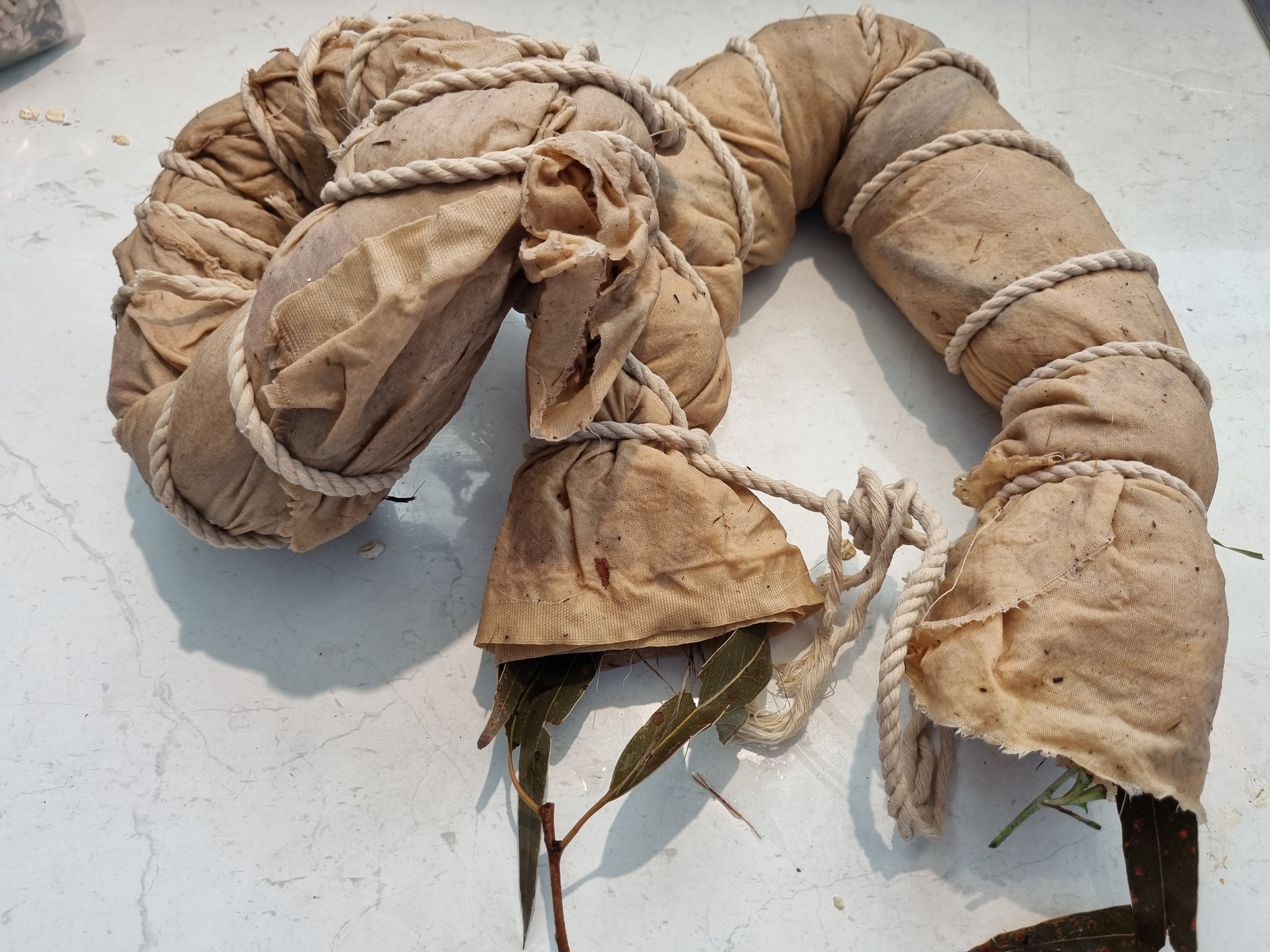
Mordanted fabric and organic material was tightly twisted and bound to produce variation and patterns in the final dye - Tessa Rixon
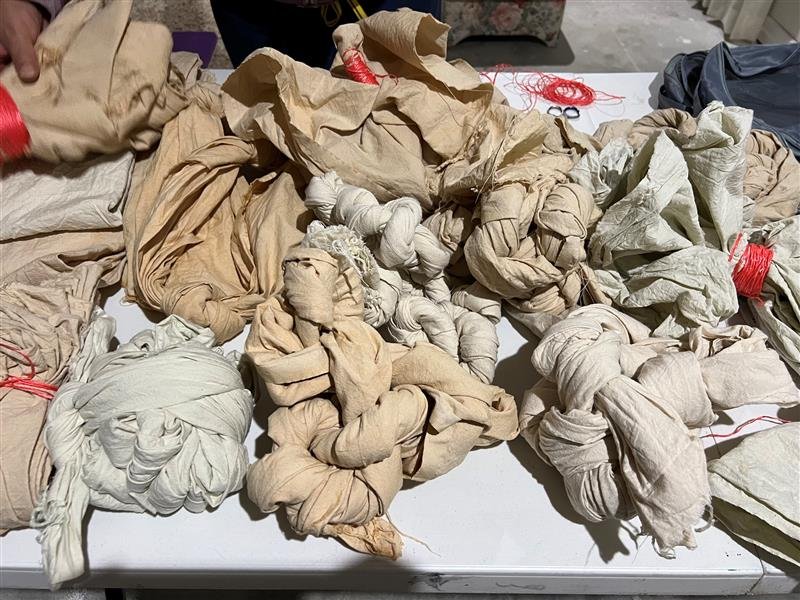
Multiple fabric and plant bundles ready for the final dying - Lani Dwyer
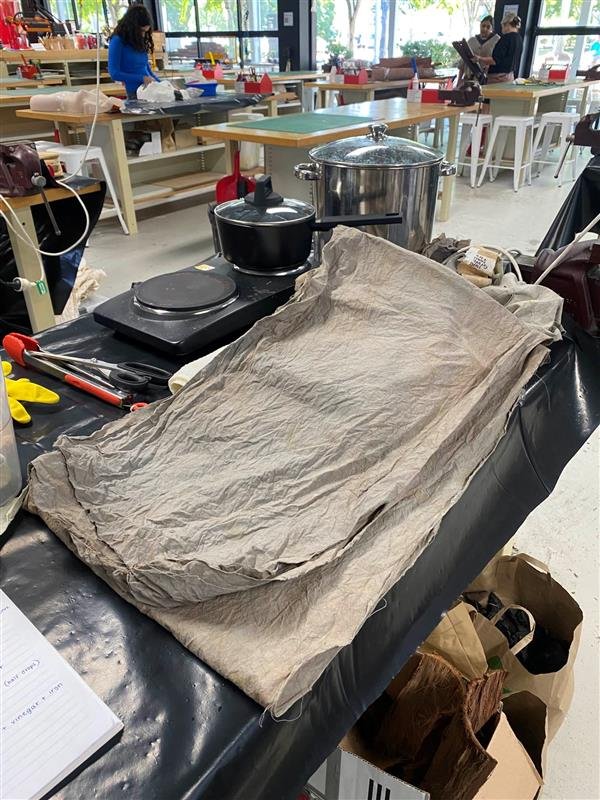
Testing iron mordanted fabric with eucalyptus dying - Josie James
EXHIBITION CREDITS
Curatorial Team: Jacob Nash and Jo Briscoe
Producers: Jo Briscoe and Richard Roberts
VCA Designers: Louisa Fitzgerald, Jodi Hope, Atulya Pulikkottil and Ishan Vivekanantham
QUT Designers: Lani Dwyer, Jazz Heckeroth and Josiene James led by Tessa Rixon
VCA Dancers: Laiken Jackson and Kitana Price led by Rheannan Port
Composer: Steve Francis
Vocal Performers: Sharon Gregory, George Hayden, Karina Lester, Kaley Nicholson and others, recorded through the 50 words project
Creative Consultants: N’arweet Professor Carolyn Briggs, Tiriki Onus, Wesley Enoch, Steve Francis, Jennifer Irwin and Rheannan Port
Production Manager: Abe Watson
Workshop manager: Alan Logan
VCA production support: Alexandra Jaensch, Thomas Vulcan, Sophie Walter and Chiara Wenban
Presenting Organisations: Victorian College of the Arts, Faculty of Fine Arts and Music, University of Melbourne and Queensland University of Technology
We acknowledge and are grateful for the direct contribution of N’arweet Professor Carolyn Briggs, Tiriki Onus, Wesley Enoch, Jennifer Irwin, Steve Francis, Rheannan Port and others to our creative development on this project.
Thanks to Adam J Howe, Shane Dunn and the Melbourne Theatre Company Scenic Department
Thanks to Professor Rachel Nordlinger and Associate Professor Nick Thieberger from the 50 words project
For dressing the VCA dancers we thank Denni Francisco from Ngali
For eucalyptus collection, dyeing assistance, studio support and advice we thank Asa Broomhall, Ian Copson, Rosemary Fitzgerald, Kate Harris, Rosa Hirikata, Bo Johnson, Molly Kendall, Harley Mann, Hayley McElhinney, Joan Morgan and Gibson Nolte.
This exhibition was made possible by the generous support of the VCA Foundation, Julie and Michael Kantor, University of Melbourne Chancellery, Faculty of Fine Arts and Music Dean Marie Sierra and VCA Director Emma Redding. QUT acknowledges the support of the School of Creative Practice for sponsoring the student involvement in this project.







